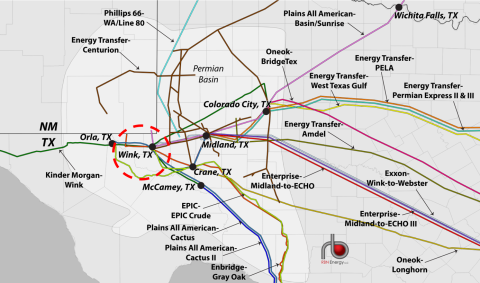Situated in West Texas’s Winkler County, the tiny city of Wink (population just under 1,000) might seem easy to overlook but it holds a special place in music history as the childhood home of Roy Orbison — he formed his first band, the Wink Westerners, there in 1949. But beyond its rich musical legacy, Wink in recent years has emerged as a key hub for crude oil connectivity in the prolific Permian Basin. Don’t blink or you might miss out on what’s happening in this dynamic locale, the subject of today’s RBN blog.
We’ve been writing a lot about the Permian in recent weeks — it’s hard not to. In Texas Hold ’Em, we explained that producers need sufficient takeaway capacity to handle their rising volumes of crude oil and associated gas. Gas takeaway constraints are already here, and the industry is eagerly anticipating the ramp up of a new pipeline: the 2.5-Bcf/d Matterhorn Express, which will come online later this year. However, still more gas takeaway capacity will be needed to keep up with the Permian’s growth trajectory (see our Around the Bend series) and several projects are in the running to provide that. Next, in Corpus Christi Bay, we noted that the Corpus Christi crude oil market is pulling as much volume as it can from the Permian via pipelines that are running nearly at capacity. The situation is complicated by the very real possibility that one or more offshore export facilities capable of fully loading Very Large Crude Carriers (VLCCs) may be built off the Texas coast (see our deepwater crude export series). Most recently, in Houston (Means I’m One Day Closer to You), we looked at the latest Permian flows to Houston and how they could change if a deepwater port is added nearby.
Figure 1. Permian Crude Oil Pipelines. Source: RBN Crude Oil Permian
So, where does Wink (dashed red oval in Figure 1 above) fit into the bigger picture? At the heart of Wink’s importance lies its role as a central point for the convergence of Permian oil. Much like Cushing, OK — but admittedly on a much smaller scale — Wink got its start as an oil hub a century or so ago as a hotbed of crude oil production. (See our eight-part Oklahoma Swing blog series and Drill Down Report for everything you need to know about Cushing.) In July 1926, oil was discovered at the Hendrick oil field near what is now called Wink, and by March 1929 — less than three years after “first oil” — the field was producing a then-astonishing 171 Mb/d. Rudimentary pipeline and railroad infrastructure was built to help deal with the massive volumes. The boom didn’t last: Local production declined significantly over the ensuing decades and so did Wink’s population, which had peaked at about 6,000 in 1930. But Wink’s location — and its oil-related infrastructure, bare-boned as it may have been — made it a logical crossroads for crude oil making its way from the Permian to the Gulf Coast.
Join Backstage Pass to Read Full Article









